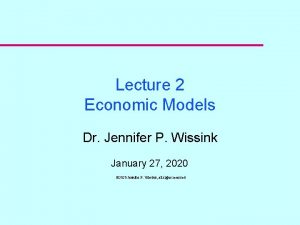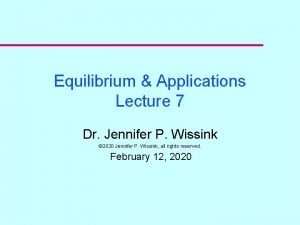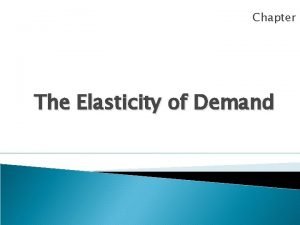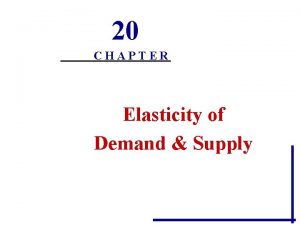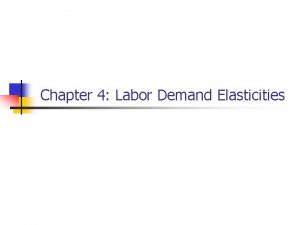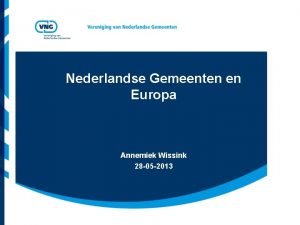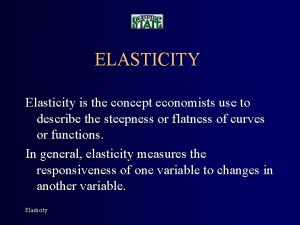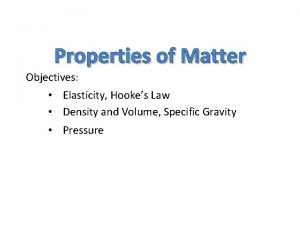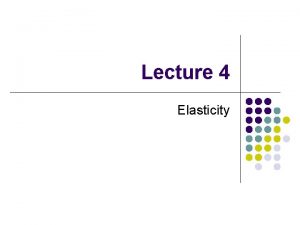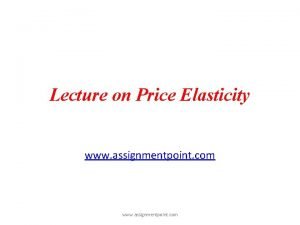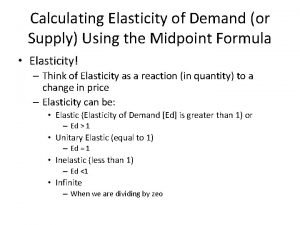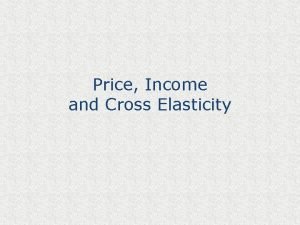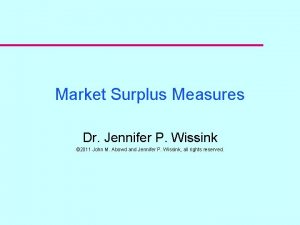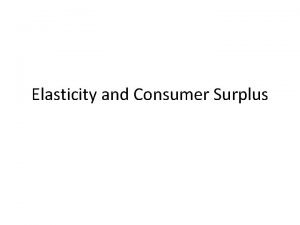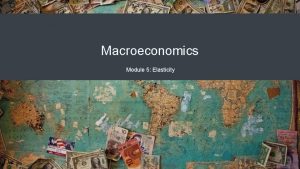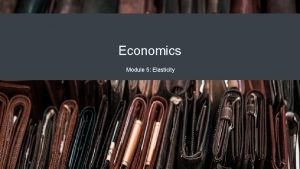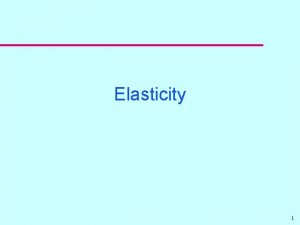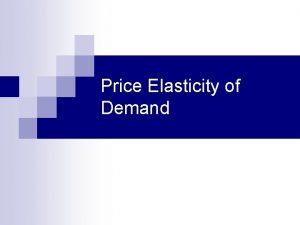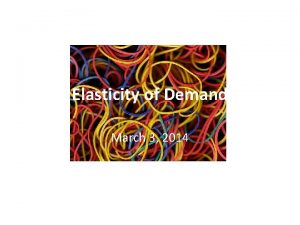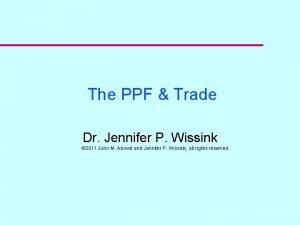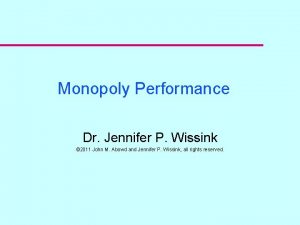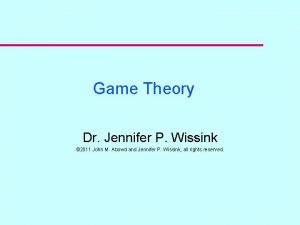Elasticity Measures Part 2 Dr Jennifer P Wissink






















- Slides: 22

Elasticity Measures Part 2 Dr. Jennifer P. Wissink © 2011 John M. Abowd and Jennifer P. Wissink, all rights reserved.

Recall: Own Price Supply Elasticities u When the price of Da. Vinci paintings increases by 1% the quantity supplied doesn’t change at all, so the quantity supplied of Da. Vinci paintings is completely insensitive to the price. – Own price elasticity of supply is 0. u When the price of beef increases by 1% the quantity supplied increases by 5%, so beef supply is very price sensitive. – Own price elasticity of supply is 5.

Supply Elasticity u Extremely similar formulas are used to calculate the own price elasticity of supply – Arc midpoint formula » Large delta style or small delta style – Point formula u Just need to substitute in – Quantity supplied and change in quantity supplied where appropriate

Supply Elasticity u Definition: u Arc Formula: u Point formula:

Example: Arc Calculation of Own Price Elasticity of Supply u u Want supply elasticity at A Use B: QS=9 and P=5 Use C: QS=16 and P=7 % change in = (16 -9)/((16+9)/2)*100 = 56% Nonlinear Supply Curve 12 10 QS % change in P = (7 -5)/((7+5)/2)*100 = 33. 33% C 8 Price u 6 4 B A 2 0 0 2 4 6 8 10 12 14 16 18 20 22 24 26 28 30 u Supply elasticity at A = 56/33. 33 = 1. 68 Quantity

Example: Point Calculation of Own Price Elasticity of Supply u Suppose you are given: QS = -10 + 4 P – Note, that’s the same as: PS = 2. 50 +. 25 Q u u u Suppose you want the exact own price elasticity of supply at P = $12 At P = $12, QS = -10 + 48 = 38 Note: (d. QS/d. P) = 4 – (Slope of drawn supply curve =. 25, so. . 1/slope = 4) u So supply elasticity at P=$12 is. . . (4) • (12/38) = 48/38 = 1. 26

Some Technical Definitions For Extreme Elasticity Values u Perfectly elastic means the quantity demanded or supplied is as price sensitive as possible. – a. k. a. completely elastic – a. k. a. infinitely elastic u Perfectly inelastic means that the quantity demanded or supplied has no price sensitivity at all. – a. k. a. completely inelastic

Perfectly Elastic Demand u u Demand is perfectly elastic when a 1% change in the price would result in an infinite change in quantity demanded. Example: Price Perfectly Elastic Demand (elasticity = -¥) Quantity

Perfectly Inelastic Demand u u Demand is perfectly inelastic when a 1% change in the price would result in no change in quantity demanded. Example: Price Perfectly Inelastic Demand (elasticity = 0) Quantity

Perfectly Inelastic Supply u u Supply is perfectly inelastic when a 1% change in the price would result in no change in quantity supplied. Example: wheat? – At harvest? Price Perfectly Inelastic Supply (elasticity = 0) » Yes. – Across planting seasons? » No. Quantity

Perfectly Elastic Supply u u Supply is perfectly elastic when a 1% change in the price would result in an infinite change in quantity supplied. Example: wheat? Price Perfectly Elastic Supply (elasticity = ¥) – Across planting seasons? » Yes. Quantity

Determinants of Elasticity u What is a major determinant of the own price elasticity of demand? – Availability of substitutes in consumption. u What is a major determinant of the own price elasticity of supply? – Availability of alternatives in production.

Real World Example – Getting It Wrong u Gas taxes in Washington DC, 1980 – Extra 6% tax imposed Aug 16, 1980 to raise much needed revenue for D. C. – Increased price at pump by 8¢ (a nearly 6% increase). – By end of first month, QD down by 27. 5%. – elasticity = 27. 5÷ 6 = 4. 5 pretty darn elastic! – Way off on expected revenue, too. – By October, sales had dropped by 40% and 242 gas station workers were laid off. – Tax lifted by Mayor Marion Barry on November 24, 1980. – What went wrong? What didn’t they account for?

Real World Example – Getting It Wrong

Own Price Elasticity of Demand & Total Expenditures u u u Question: What happens to total expenditures made by buyers (TE) in a market when market price increases? Note: TE = P • QD P↑ tends to increase TE, but it also decreases QD. QD↓ tends to decreases TE. So what happens to TE? Knowing own price elasticity will help! – If demand is price ELASTIC, then TE ↓ » Why? – If demand is price INELASTIC, then TE ↑ » Why? u On you own: reverse this argument to determine the relationship between total expenditure and elasticity when you consider a price decrease!

Bridge Toll Example u u Suppose: Current toll for the George Washington Bridge is $6. 00/trip. Suppose: The quantity demanded at $6. 00/trip is 100, 000 trips/hour. So: TE on trips per hour = $600, 000 If the own price elasticity of demand for bridge trips is known to be 2. 0, then what is the effect of a 10% toll increase? – Note: since demand is price ELASTIC TE↓ u u u A 10% toll increase means the price is now $6. 60 per trip. If η=-2, a toll increase of 10% implies a 20% decline in the quantity demanded. If there is a 20% decline in trip, number of trips falls to 80, 000/hour. Total expenditure falls to $528, 000/hour (= 80, 000 x $6. 60). $528, 000 < $600, 000

Own Price Elasticity of Demand & Total Expenditure with Linear Demand $TE Price elastic Demand Price inelastic Quantity u u u Quantity Starting at the “top” of the demand curve, where demand is price elastic, as price falls, and quantity demanded rises, total expenditures rise, but increase at a decreasing rate. At the midpoint, where demand is unit elastic, total expenditures will be at their maximum value. As you continue down the demand curve, where demand is now price inelastic, as price falls, and quantity demanded rises, total expenditures fall.

Cross-Price Elasticity of Demand u Elasticity of demand with respect to the price of a complementary good (cross-price elasticity) – This elasticity is negative because as the price of a complementary good rises, the quantity demanded of the good itself falls. – Example: software is complementary with computers. When the price of software rises the quantity demanded of computers falls. u Elasticity of demand with respect to the price of a substitute good (also a cross-price elasticity) – This elasticity is positive because as the price of a substitute good rises, the quantity demanded of the good itself rises. – Example: hockey is substitute for basketball. When the price of hockey tickets rises the quantity demanded of basketball tickets rises. u Cross-price elasticities quantify effects like these.

Cross-Price Elasticity of Demand u u u Definition: Arc Formula: Point Formula:

Income Elasticity of Demand u The elasticity of demand with respect to a consumer’s income is called the income elasticity. – When the income elasticity of demand is positive (normal good), consumers increase their purchases of the good as their incomes rise (e. g. automobiles, food). » When the income elasticity of demand is greater than 1 (luxury good), consumers increase their purchases of the good more than proportionate to the income increase (e. g. ski vacations, haute cuisine). » When the income elasticity of demand is positive but less than 1 (a necessity), consumers increase their purchases of the good less than proportionate to the income increase (e. g. socks, bread). – When the income elasticity of demand is negative (inferior good), consumers reduce their purchases of the good as their incomes rise (e. g. spam, potatoes).

Income Elasticity of Demand u u u Definition: Arc Formula: Point Formula:

All Four Elasticities You Need to Know u Own Price Elasticity of Demand u Cross Price Elasticity of Demand u Income u Own Elasticity of Demand Price Elasticity of Supply
 Jennifer wissink cornell
Jennifer wissink cornell Jennifer wissink
Jennifer wissink Jennifer wissink
Jennifer wissink Total outlay method formula
Total outlay method formula Price elasticity of supply measures how responsive
Price elasticity of supply measures how responsive Cross wage elasticity of labor demand
Cross wage elasticity of labor demand Elasticity measures
Elasticity measures Annemiek wissink
Annemiek wissink Repeated measures design
Repeated measures design The part of a shadow surrounding the darkest part
The part of a shadow surrounding the darkest part Brainpop ratios
Brainpop ratios Technical description
Technical description Part whole model subtraction
Part whole model subtraction Bar part
Bar part Unit ratio definition
Unit ratio definition Part to part variation
Part to part variation Facts about elasticity
Facts about elasticity Properties of matter elasticity
Properties of matter elasticity Elasticity
Elasticity Elasticity
Elasticity Price and income elasticity
Price and income elasticity Cross elasticity of demand midpoint formula
Cross elasticity of demand midpoint formula Price
Price
